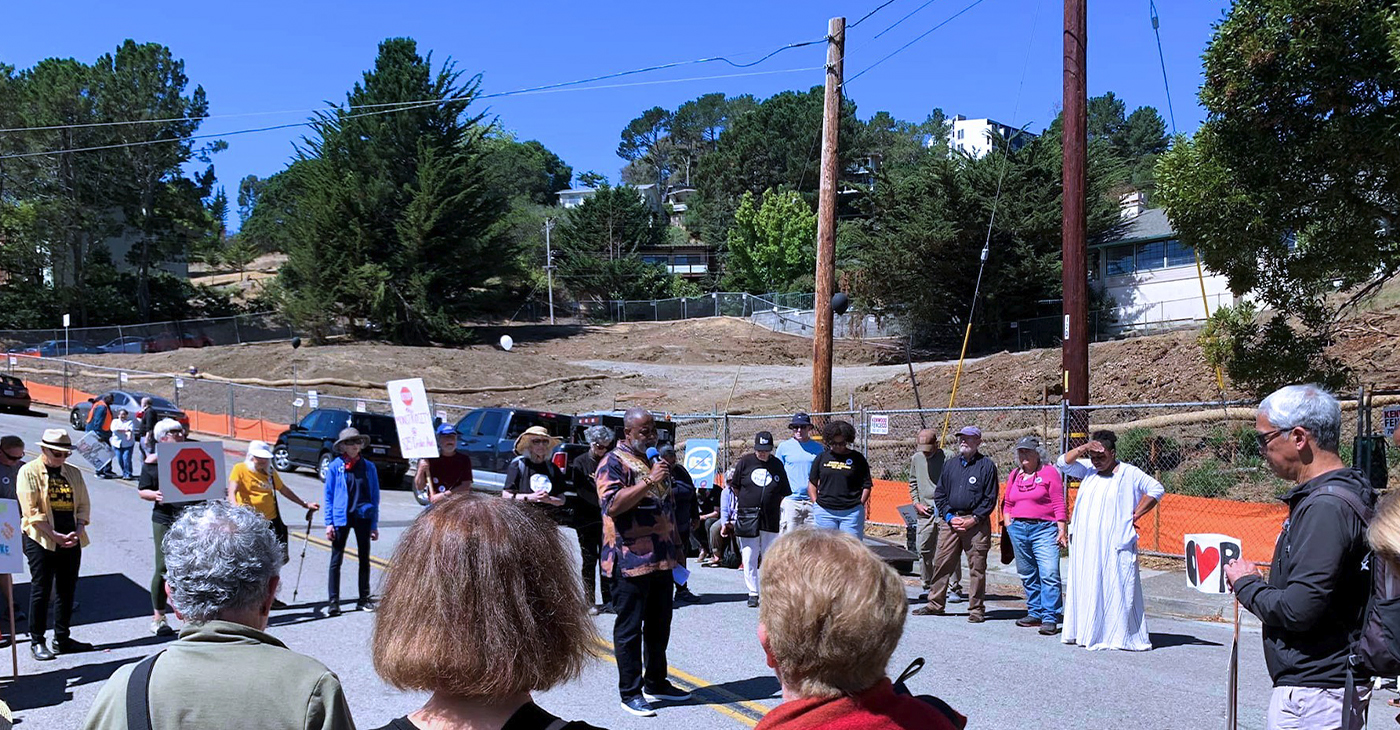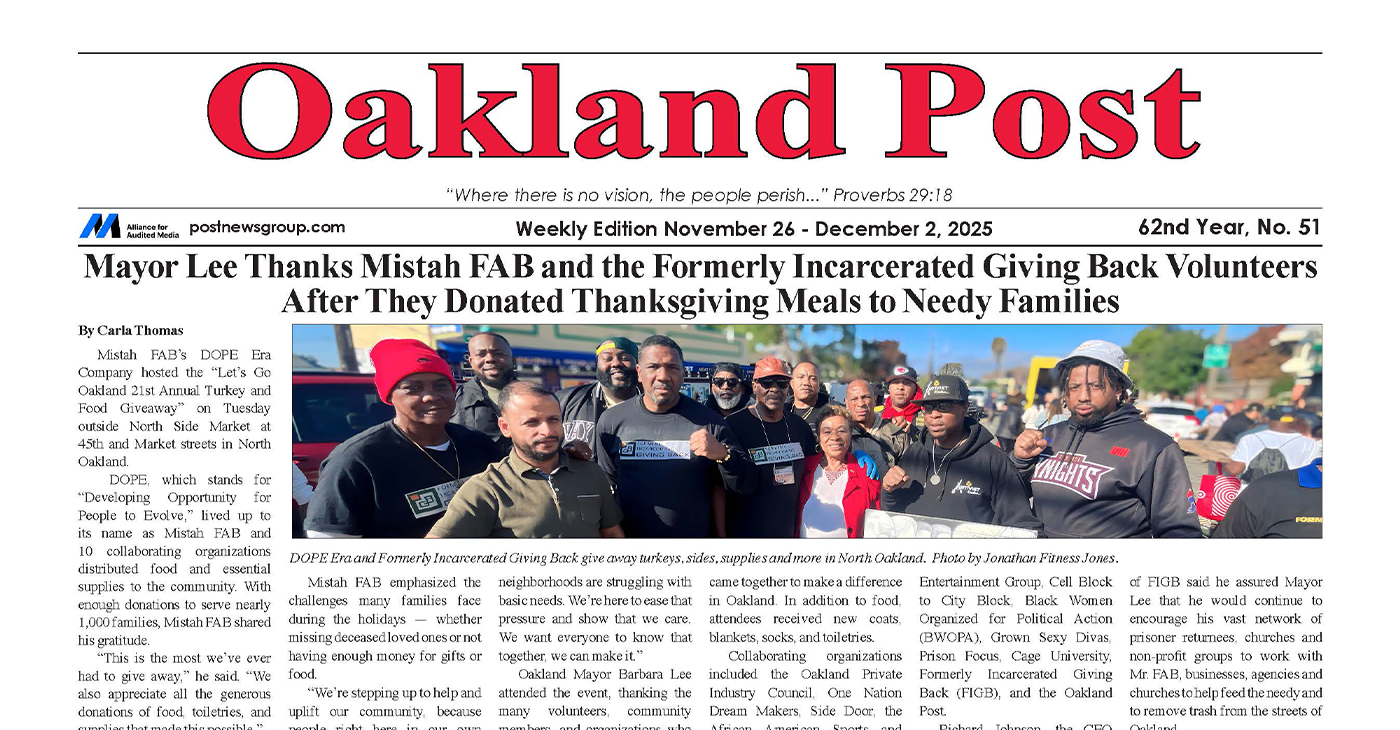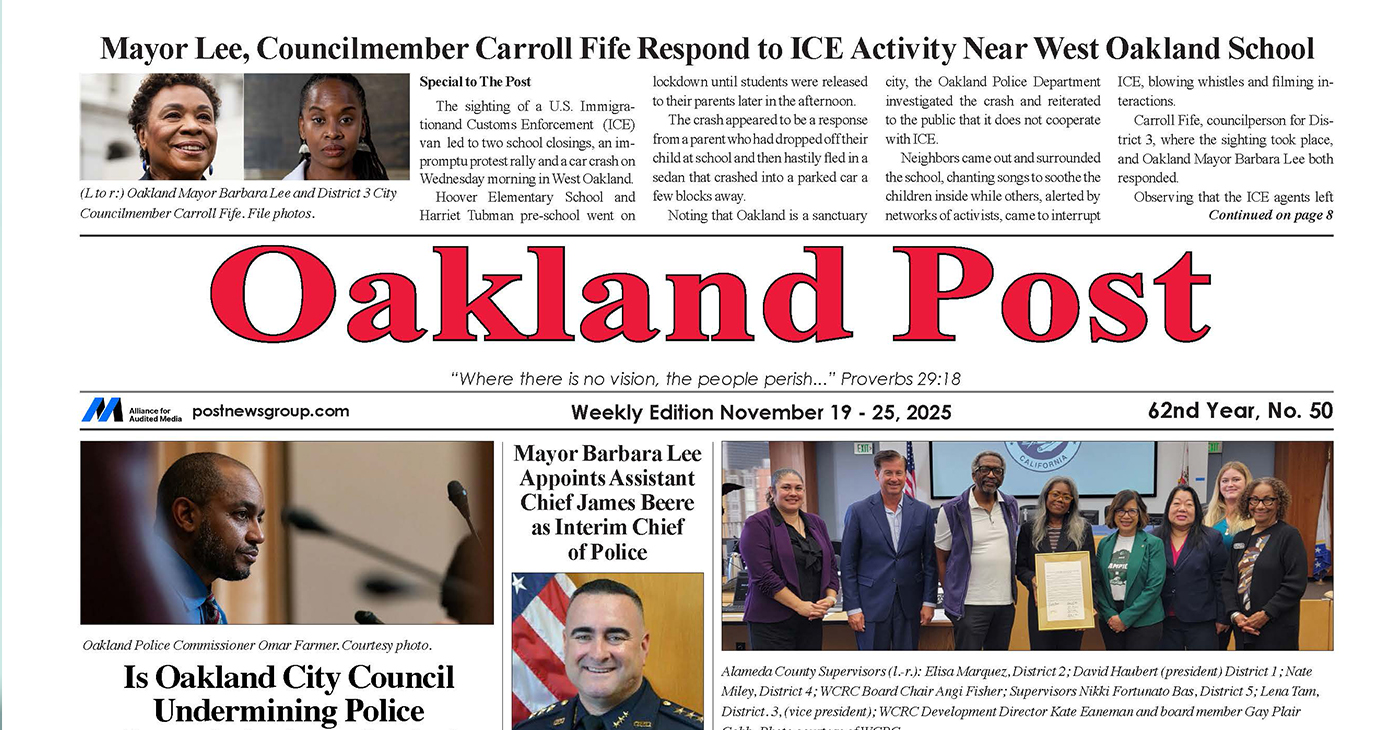Bay Area
Judge Halts Funding for Housing Protested by Marin City Residents
In a ruling that marks a major milestone for affirming the concerns of Marin City residents, a Marin County judge has issued a preliminary injunction to halt public funding for the construction of a five-story, 74-unit housing development at 825 Drake Ave. in Marin City, a historically Black community that already holds a disproportionate amount of public and affordable housing in the wealthy enclave of Marin County.

By Godfrey Lee
Save Our City, a community group working to stop the proposed development at 825 Drake Ave. in Marin City, issued a press release regarding the status of the project. It is summarized below.
In a ruling that marks a major milestone for affirming the concerns of Marin City residents, a Marin County judge has issued a preliminary injunction to halt public funding for the construction of a five-story, 74-unit housing development at 825 Drake Ave. in Marin City, a historically Black community that already holds a disproportionate amount of public and affordable housing in the wealthy enclave of Marin County.
Because the 825 Drake Ave. development was approved under SB 35, a law intended to fast-track affordable housing projects without public notice or hearings, the residents of Marin City were not given notice of the development until after it was approved by the Marin County Board of Supervisors.
While SB 35 was adopted to sideline wealthy enclaves that have historically stonewalled affordable housing projects in their communities, it has been used in Marin City to create even more housing density in the County’s most racially diverse, economically disadvantaged and politically disempowered community.
The well-intentioned law failed to carve out adequate protections for low-income California communities that already have a grossly disproportionate share of their region’s affordable and public housing options, and it has failed to ensure that the term “affordable” takes into account low-income communities like Marin City that are embedded in regions with the highest Average Median Income levels in the state.
On Sept. 6, Marin County Superior Court Judge Stephen P. Freccero entered a Limited Preliminary Injunction on behalf of a Marin City organization, Save Our City (SOC), temporarily halting public funding approved by the Marin County Board of Supervisors for the construction of a five-story, 74-unit housing development at 825 Drake Ave. in Marin City.
SOC had filed suit on May 18 to invalidate the Board’s approval of the bonds, arguing that the Board had improperly failed to exercise its discretion in deciding whether to approve the bonds. Transcripts of Board proceedings showed that Board members erroneously believed that a recent state law allowing expedited approval for certain housing developments had stripped the Board of the power to decide whether funding such a development was in the community and County’s best interests.
The Court agreed with SOC, finding that Board approval of the bonds did require that “the [local authority] decide the matter [at issue] after considering local residents’ views, and by clear implication requires the [local authority] to consider city priorities and housing needs, the wisdom of preferential financing for the project, and all other relevant considerations to which elected representatives normally give weight in executing their office.”
Given these considerations, the Court stated that the Board’s refusal “to consider or exercise its lawful discretion may be grounds to invalidate the resolution.”
Save Our City was formed to stop this large-scale development from being forced on the small, historically Black community of Marin City, which is already densely saturated with affordable housing and has only one park in the entire city.
The proposed development would encroach on that limited open space available to Marin City residents and block sunlight, particularly from the seniors living in existing affordable housing directly next to the proposed site.
Meanwhile, the wealthy and predominantly white surrounding communities in Marin County offer little to no affordable housing options for Marin County residents and have ample open green and recreational spaces for their community.
The Marin County Board of Supervisors is responsible for overseeing affordable and public housing options in unincorporated Marin. To address the housing shortages in California, state law requires each region to supply housing to meet its Regional Housing Needs Allocation (RHNA).
The RHNA is intended to promote several objectives including: (1) increase housing supply and the mix of housing types in an equitable manner; (2) discourage housing development patterns that segment communities, (3) affirmatively further fair housing. Marin County’s approval of the 825 Drake Ave. project in Marin City violates all these principles:
Marin City already has the most public housing in Marin County. While Marin City represents only 1% of Marin County in size (356 acres), it already possesses 60% of the public housing units available in all of Marin County (296 of 496 total public housing units).
Marin City already has the highest housing density. In Marin City 61.4% of the housing structures are buildings with five or more units. This is greater than the surrounding predominantly white and wealthy unincorporated communities, with Strawberry being the second largest at 42%.
Because Marin County has one of the nation’s highest Average Median Income (AMIs), the “affordable” 825 Drake Ave. housing development will not be affordable to most of the residents in Marin City and will perpetuate further gentrification of this community.
Marin County has repeatedly denied Marin City residents the courtesy of notice or an opportunity to be heard concerning the County’s approval of the 825 Drake Ave. project. During the County’s March 21 hearing to consider approval of $40 million in non-taxable bonds to support developer Caleb Roope’s construction of 825 Drake Ave., the residents raised their concerns about inequity and the project’s impacts on the community. With just five days’ notice before the hearing, community members scrambled to provide substantive feedback during the limited minutes of public comment. However, their comments fell upon deaf ears.
It is on this basis that Save Our City filed its lawsuit, arguing that the Board failed to perform their required duty under the law — which was to use their discretion to weigh whether the “governmental interest in not giving approval [of the bonds] may outweigh the desirability of furnishing low rent housing.”
Because of SB 35’s fast-track approval process, this bond hearing was the community’s sole opportunity to be heard on the devastating effects of the 825 Drake Ave. development. Instead of weighing these important interests, Board members made repeated statements about how their “hands were tied” and they did not have discretion to deny the bonds.
SOC co-founder Bettie Hodges observed that “The County has failed to represent Marin City throughout this process. First, we are told that they were not legally required to give us notice of 825 Drake’s approval, then, in the bond hearing, they tell us that they did not have discretion to consider our comments.
“We have been completely silenced at every turn. Our elected representatives could and should have given us the courtesy of notice and an opportunity to be heard, especially given the inequities in Marin City that are a direct result of Marin County’s history of discriminatory housing practices.”
Marilyn Mackel, co-founder of SOC, stated that “I was disappointed to see that even in the preliminary injunction hearing, the County stood silent. They did not defend their approval of the bonds, but also did not have the moral fortitude to concede that they failed to consider our concerns when they approved the bonds. Their repeated choice to stand silent is not just an abdication of responsibility, it is a perpetuation of economic and racial segregation in Marin County.”
Save Our City’s Lawsuit seeks to preserve this small piece of open space in Marin City. Marin County is known for its green and open spaces, including hiking trails, streams, open fields and waterways. While the rest of unincorporated Marin County is characterized by these copious green spaces, Marin City has only one small park that is made of concrete and astro-turf.
For more information, please contact: Bettie Hodges at bettie@hannahprograms.org, or Marilyn Mackel at mmackel@gmail.com
Alameda County
Seth Curry Makes Impressive Debut with the Golden State Warriors
Seth looked comfortable in his new uniform, seamlessly fitting into the Warriors’ offensive and defensive system. He finished the night with an impressive 14 points, becoming one of the team’s top scorers for the game. Seth’s points came in a variety of ways – floaters, spot-up three-pointers, mid-range jumpers, and a handful of aggressive drives that kept the Oklahoma City Thunder defense on its heels.

By Y’Anad Burrell
Tuesday night was anything but ordinary for fans in San Francisco as Seth Curry made his highly anticipated debut as a new member of the Golden State Warriors. Seth didn’t disappoint, delivering a performance that not only showcased his scoring ability but also demonstrated his added value to the team.
At 35, the 12-year NBA veteran on Monday signed a contract to play with the Warriors for the rest of the season.
Seth looked comfortable in his new uniform, seamlessly fitting into the Warriors’ offensive and defensive system. He finished the night with an impressive 14 points, becoming one of the team’s top scorers for the game. Seth’s points came in a variety of ways – floaters, spot-up three-pointers, mid-range jumpers, and a handful of aggressive drives that kept the Oklahoma City Thunder defense on its heels.
One of the most memorable moments of the evening came before Seth even scored his first points. As he checked into the game, the Chase Center erupted into applause, with fans rising to their feet to give the newest Warrior a standing ovation.
The crowd’s reaction was a testament not only to Seth’s reputation as a sharpshooter but also to the excitement he brings to the Warriors. It was clear that fans quickly embraced Seth as one of their own, eager to see what he could bring to the team’s championship aspirations.
Warriors’ superstar Steph Curry – Seth’s brother – did not play due to an injury. One could only imagine what it would be like if the Curry brothers were on the court together. Magic in the making.
Seth’s debut proved to be a turning point for the Warriors. Not only did he contribute on the scoreboard, but he also brought a sense of confidence and composure to the floor.
While their loss last night, OKC 124 – GSW 112, Seth’s impact was a game-changer and there’s more yet to come. Beyond statistics, it was clear that Seth’s presence elevated the team’s performance, giving the Warriors a new force as they look to make a deep playoff run.
Activism
Oakland Post: Week of November 26 – December 2, 2025
The printed Weekly Edition of the Oakland Post: Week of November 26 – December 2, 2025

To enlarge your view of this issue, use the slider, magnifying glass icon or full page icon in the lower right corner of the browser window.
Activism
Oakland Post: Week of November 19 – 25, 2025
The printed Weekly Edition of the Oakland Post: Week of November 19 – 25, 2025

To enlarge your view of this issue, use the slider, magnifying glass icon or full page icon in the lower right corner of the browser window.
-

 Activism3 weeks ago
Activism3 weeks agoOakland Post: Week of November 12 – 18, 2025
-

 Activism2 weeks ago
Activism2 weeks agoIN MEMORIAM: William ‘Bill’ Patterson, 94
-

 Activism3 weeks ago
Activism3 weeks agoHow Charles R. Drew University Navigated More Than $20 Million in Fed Cuts – Still Prioritizing Students and Community Health
-

 Bay Area3 weeks ago
Bay Area3 weeks agoNo Justice in the Justice System
-

 #NNPA BlackPress3 weeks ago
#NNPA BlackPress3 weeks agoThe Perfumed Hand of Hypocrisy: Trump Hosted Former Terror Suspect While America Condemns a Muslim Mayor
-

 #NNPA BlackPress2 weeks ago
#NNPA BlackPress2 weeks agoTrump’s Death Threat Rhetoric Sends Nation into Crisis
-

 #NNPA BlackPress4 weeks ago
#NNPA BlackPress4 weeks agoProtecting Pedophiles: The GOP’s Warped Crusade Against Its Own Lies
-

 #NNPA BlackPress2 weeks ago
#NNPA BlackPress2 weeks agoLewis Hamilton set to start LAST in Saturday Night’s Las Vegas Grand Prix




















































